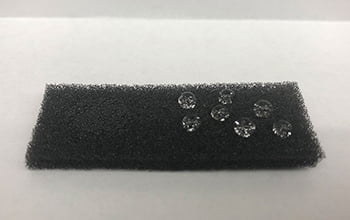
[ad_1]
Research News
Highly porous sponge selectively soaks up oil, sparing water and wildlife
June 5, 2020
A team funded by the National Science Foundation has developed a porous smart sponge that selectively soaks up oil in water.
With an ability to absorb more than 30 times its weight in oil, the sponge could be used to inexpensively and efficiently clean up oil spills without harming marine life. The sponge can be reused dozens of times without losing its effectiveness.
“Oil spills have devastating and immediate effects on the environment, human health and the economy,” said Northwestern’s Vinayak Dravid, who led the research. “Although many spills are small and may not make the evening news, they are still profoundly invasive to the ecosystem and surrounding community. Our sponge can remediate these spills in a more economic, efficient and eco-friendly manner than any of the current state-of-the-art solutions.”
The research results were published in the journal Industrial Engineering and Chemical Research.
Oil spill cleanup is an expensive and complicated process that often harms marine life and causes damage to the environment in addition to the spill. Current solutions include burning the oil, using chemical dispersants to break oil down into very small droplets, skimming the oil floating on top of the water or absorbing it with expensive, unrecyclable sorbents.
The new solution bypasses these challenges by selectively absorbing oil and leaving clean water and unaffected marine life behind.
The secret lies in a nanocomposite coating of magnetic nanostructures and a carbon-based substrate that is oleophilic (attracts oil), hydrophobic (resists water) and magnetic. The nanocomposite’s nanoporous 3D structure selectively interacts with and binds to the oil molecules, capturing and storing the oil until it is squeezed out.
The magnetic nanostructures give the smart sponge two additional abilities: controlled movement in the presence of an external magnetic field and desorption of adsorbed components, such as oil, in a simulated and remote manner.
“These results build on earlier efforts supported by NSF’s Ceramics Program to overcome the negative impact of oil spills,” says Lynnette Madsen, a program director in NSF’s Division of Materials Research. “This novel approach has the potential for other applications as well.”
—
NSF Public Affairs,
researchnews@nsf.gov
[ad_2]
Source link
China PR







